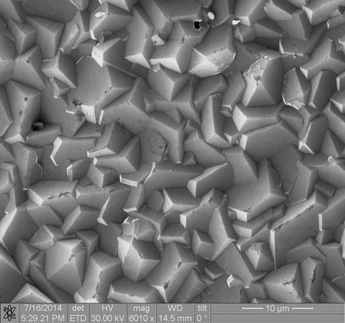Better remote-sensing explosive detectors
The beginning of the end of full-body scanners?
Standing in a full-body scanner at an airport isn't fun, and the process adds time and stress to a journey. It also raises privacy concerns. Researchers now report in ACS' The Journal of Physical Chemistry Letters a more precise and direct method for using that "terahertz" (THz) technology to detect explosives from greater distances. The advance could ultimately lead to detectors that survey a wider area of an airport without the need for full-body scanners.
R. Kosloff and colleagues explain that using THz spectroscopy by itself is challenging for sensing far-away explosives. This technology uses beams of electromagnetic radiation that lie between microwaves, like those used in kitchen ovens, and the infrared rays used in TV remote controls. In addition to screening people for explosives, it is used at drug companies for quality-control purposes and, most recently, to study the layers of paint of ancient works of art. With recent advances, the technique is becoming a strong candidate for detecting substances from a distance. Other researchers have developed remote-sensing THz instruments, but they combine it with a second method to identify substances. Kosloff's group aimed to use THz directly to eventually develop even better remote sensors.
They developed a computational tool and used it to successfully identify two explosives, RDX and TATP, with THz data directly. RDX is a component of plastic explosives, and TATP is an explosive found in the shoes of the "shoe bomber" in 2009. "The ability to perform experimentally and simulate multidimensional spectroscopy should significantly enhance the screening ability of THz spectroscopy," say the researchers.
Most read news
Organizations
Other news from the department science

Get the chemical industry in your inbox
From now on, don't miss a thing: Our newsletter for the chemical industry, analytics, lab technology and process engineering brings you up to date every Tuesday and Thursday. The latest industry news, product highlights and innovations - compact and easy to understand in your inbox. Researched by us so you don't have to.
Most read news
More news from our other portals
See the theme worlds for related content
Topic World Spectroscopy
Investigation with spectroscopy gives us unique insights into the composition and structure of materials. From UV-Vis spectroscopy to infrared and Raman spectroscopy to fluorescence and atomic absorption spectroscopy, spectroscopy offers us a wide range of analytical techniques to precisely characterize substances. Immerse yourself in the fascinating world of spectroscopy!

Topic World Spectroscopy
Investigation with spectroscopy gives us unique insights into the composition and structure of materials. From UV-Vis spectroscopy to infrared and Raman spectroscopy to fluorescence and atomic absorption spectroscopy, spectroscopy offers us a wide range of analytical techniques to precisely characterize substances. Immerse yourself in the fascinating world of spectroscopy!
Topic world Sensor technology
Sensor technology has revolutionized the chemical industry by providing accurate, timely and reliable data across a wide range of processes. From monitoring critical parameters in production lines to early detection of potential malfunctions or hazards, sensors are the silent sentinels that ensure quality, efficiency and safety.

Topic world Sensor technology
Sensor technology has revolutionized the chemical industry by providing accurate, timely and reliable data across a wide range of processes. From monitoring critical parameters in production lines to early detection of potential malfunctions or hazards, sensors are the silent sentinels that ensure quality, efficiency and safety.





























































